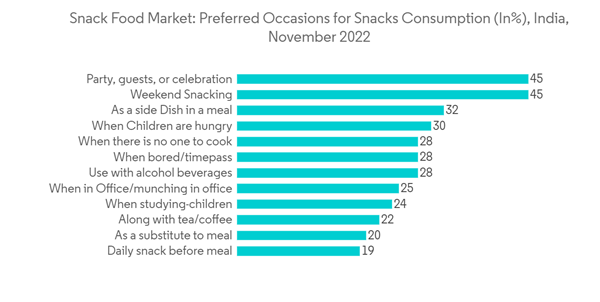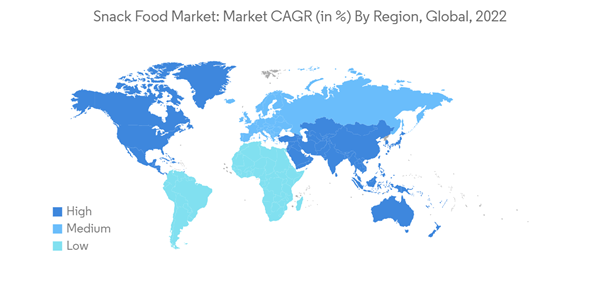The snack food market size is expected to grow from USD 256.26 billion in 2024 to USD 653.72 billion by 2029, at a CAGR of 16.89% during the forecast period (2024-2029).
The prominent players are focusing on new product developments, expansions, partnerships, and mergers and acquisitions as strategies to cater to the increasing demand from consumers, thereby gaining a competitive advantage in the market. To strengthen their hold in the market, these companies are innovating their flavors, expanding their target markets, and strengthening their distribution channels. Also, companies compete on different factors, including product offerings, quality, taste, flavors, price, functionality, size, packaging, and marketing activities, to gain a competitive advantage in the market.
This product will be delivered within 2 business days.
Key Highlights
- Consumers prefer their food to be easy to carry and quickly accessible, making snack food the best option. Witnessing the sudden upsurge, manufacturers eventually launched products enriched with protein, vitamins, and nutrients, giving consumers on-the-go nutrition while snacking. Healthy alternatives have emerged on the market as a result of consumer desire for options for low-fat, low-sugar, and high-protein snacks. Functional snacking is gaining more importance these days as people are replacing their meals with snacks and need proper nutrition through snacking.
- According to the 2021 report of Mondelez International about snacking habits, 72% of people look for portion-controlled snacking options, which means they require their nutrition needs to be fulfilled by snacking. The variety of products available on the snack food market, which cater to a variety of tastes and preferences, includes chips, nuts, granola bars, and more. The demand for snacks produced from natural and sustainable ingredients has also increased as plant-based diets and clean-label preferences have grown in popularity.
- Over the medium term, snack food emerged as an alternative to full-fledged meals with a paradigm shift in consumer behavior patterns. Snacks are evolving to cater to changing demand as empowered consumers increasingly seek tasty, nutritional, and sustainable foods to fuel their on-the-go lifestyles.
- For instance, 31% of consumers in the United States consumed snack food once a day in May 2023, according to the International Food Information Council. Snacking is on the rise as the demand for convenience and portability fuels consumption, with premiumization spurring innovation and variety in fresh, better-for-you, and functional snacks. Localization encourages the use of bold and spicy flavors and exotic ingredients to appeal to global palates, driving growth in the regional markets. Convenience also drives the online sales of ready-to-eat snacks, with snack foods being one of the top food categories purchased through e-commerce channels.
Snack Food Market Trends
Rising Demand for Convenient Foods Drives the Market
- Modern consumers frequently need help to sit down for traditional meals, especially those with busy schedules. While on the go, snack foods offer a quick and convenient option to fulfill appetites and control hunger. Many nuclear families live in big cities, and due to both parents working, the kids have a habit of snacking at least once a day instead of having a whole meal.
- Snacks are often portable and packaged for ease of use, making them appropriate for consumption in a variety of locations, including offices, vehicles, and public transportation. Customers can quickly grab snacks while traveling or in urban areas because of convenience stores and vending machines. More people are moving into cities, which promotes a culture of convenience where snacks can be used as functional meal replacements, driving the snack food market.
- Many people munch while at work since it is handy and keeps their energy levels up without disrupting their work. Consuming snacks while watching films, sporting events, streaming entertainment, and partying at home is a common practice. For instance, 45% of Indians preferred party and celebration occasions for snack consumption in November 2022, according to the report published by Godrej Yummiez.
- Customers can browse and order a large variety of snacks online from the comfort of their homes, greatly boosting convenience. According to the Campaign Middle East, snack food is the fastest-growing e-commerce category in the United Arab Emirates, with a growth rate of 855% in 2022.
Asia-Pacific Holds the Largest Market Share
- Snack food products are largely consumed in developing regions with high commercialization and urbanization. Asia-Pacific represents the largest and fastest-growing market for snack food products owing to increasing demand from developing countries, such as India and China. The spread of Western eating habits to the developing world and growing urbanization have helped improve market penetration for global players entering the developing nations of Asia-Pacific. For instance, the size of the organized Western savory snacks market in India was INR 242 billion in 2022, according to the Associated Chambers of Commerce and Industry of India.
- The Chinese snack food market registered stable growth in the study period, and it is expected to improve further during the forecast period. Moreover, the rising demand for on-the-go snacking with additional nutritional content is driving the demand for meat-based snacks in the market. Rising numbers of tourists to China and India fuel market expansion. Snacks are a common source of convenient sustenance for tourists and travelers while on trips or while experiencing new places.
- Additionally, the higher protein content and lower fat and carb contents of products augment their demand among sports and fitness enthusiasts. Furthermore, Chinese snack manufacturers are focusing on research and development to innovate healthy snack options. For instance, in April 2023, Dongguan, Guangdong province-based snack maker Hsu Fu Chi, collaborated with the South China University of Technology to develop a healthy snack research center to debut new trends in Chinese consumer preferences.
Snack Food Industry Overview
The Snack Food market is fragmented, and the competition in the snack food market is high, mostly in developed countries, where a large number of snack food manufacturing companies are operating. Some of the major players in the snack food market are PepsiCo Inc., The Kellogg Company, Unilever Plc, Nestle SA, and General Mills Inc.The prominent players are focusing on new product developments, expansions, partnerships, and mergers and acquisitions as strategies to cater to the increasing demand from consumers, thereby gaining a competitive advantage in the market. To strengthen their hold in the market, these companies are innovating their flavors, expanding their target markets, and strengthening their distribution channels. Also, companies compete on different factors, including product offerings, quality, taste, flavors, price, functionality, size, packaging, and marketing activities, to gain a competitive advantage in the market.
Additional Benefits:
- The market estimate (ME) sheet in Excel format
- 3 months of analyst support
This product will be delivered within 2 business days.
Table of Contents
1 INTRODUCTION
4 MARKET DYNAMICS
5 MARKET SEGMENTATION
6 COMPETITIVE LANDSCAPE
Companies Mentioned (Partial List)
A selection of companies mentioned in this report includes, but is not limited to:
- PepsiCo Inc.
- The Kellogg Company
- Nestle SA
- General Mills Inc.
- Mondelēz International, Inc
- Conagra Brands Inc.
- Link Snacks Inc.
- Unilever Plc
- Hunter Foods LLC
- Lundberg Family Farms
Methodology

LOADING...










